Now is the time to prepare your portfolio for rate cuts
2023 was marked by the end of central bank rate hiking cycles for most of the major developed market economies. And now that investors are in the holding pattern between the last of the hikes and the first of the cuts, fixed income investors are making their best returns.
2024 will likely bring the start of rate cuts in most of these jurisdictions. Inflation is moving back towards target, unemployment is loosening at an appropriate pace, and the starting point for both fiscal and monetary policy is historically tight. Indeed, we think now is the time for diversified investors to be planning their portfolios for a declining interest rate cycle.
In this video, we'll discuss where we left 2023 and why we think the beginning of 2024 presents a ripe opportunity to lock in historically high yields before the start of the rate-cutting cycle.
TRANSCRIPT
John Valtwies, Account Manager: Welcome to the first trade floor video of 2024.
Well Adam, in 2023, I think it's fair to say investors were afraid of the bond market, afraid of the possibility of another sharp increase in interest rates.
Just to recap, can you distill what took place over 2023?
Adam Bowe, Portfolio Manager, Fixed Income, Australia: Yes, you're right. Investors were fretting about the bond market. I think, there's always a level of interest rates that stops people from borrowing and spending. I think in 2023, central banks in most parts of the developed world reached those levels and so when you, despite volatility, when you look point to point, 10-year government bond yields in Australia and the US started close to where they finished around 4% and despite the cash rate.
So the RBA and the Fed lifting policy rates by another 100, 125 basis points, the impact on bond returns is pretty muted. That was largely expected and priced into markets.
So when interest rates are more stable, you tend to earn your yield or carry in a bond fund.
So for high-quality core bond funds, it doesn’t matter if it was Australian ag composite style or global aggregate hedge to Aussie or investment grade credit hedged to Aussie dollars, with returns of around 6%. It’s pretty reasonable for a year when the cash rate averaged in the high 3% area.
So we've been saying it for a couple of quarters. The opportunity in core bonds hasn't looked this attractive in over ten years.
Valtwies: So I guess with that backdrop and thinking about the year ahead now, we've already seen the Fed announced they're on hold for now.
The RBA as well for now, but we know they're likely to be patient. With that in mind and the prospects for a soft landing, or that's what the markets are certainly pricing in, what should investors focus on this year?
Bowe: We do think that most central banks around the developed world have reached or really close to reaching their peak in policy rates this hiking cycle. And in fact, as we navigate 2024, interest rates in most parts of developed world will start to come down.
So why do we think that? Starting point of policy is really tight. Inflation is moving back towards target and unemployment rates are drifting higher.
For context, if we just focus on Australia, for a minute. If we look at the percentage of income households are having to dedicate to paying interest on their mortgage and paying tax to the government, it's never been this high.
So both monetary and fiscal policy are really tight here, which explains why household spending has been so sluggish.
So certainly expecting as we move through 2024 central banks will start to bring interest rates down. So for investors, they need to start turning their mind to portfolio construction, in an environment of declining interest rates.
So for context, in the US, the markets pricing the Fed to lower interest rates by about 2% over a couple of years. About half that in Australia.
So the challenge for investors that have built up large piles of cash in term deposits is, how do I maintain resilient levels of income in my portfolio as these start to reset and roll off at much lower levels of interest rates?
So that's the challenge.
The opportunity is, the flip side to the opportunity we had in 2020, which was we got the chance to lock in low rates on our mortgages. 2024 the opportunity is we get to lock in high-interest rates on our income-producing assets before they start to come down and, for core bond funds, we think it presents the most compelling opportunity for investors to do that.
The starting yield is around 5%, and they have daily liquidity.
Valtwies: Well, thanks, Adam.
And some important takeaways there for the year ahead as we move into an environment of lower interest rates, now is certainly the time to be allocated to bonds with starting yields at 5 to 6%.
Invest with the world's premier fixed income manager
For more insights, please visit our website or get in touch with your PIMCO account manager.

4 topics
1 fund mentioned

